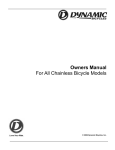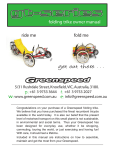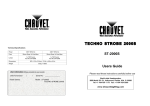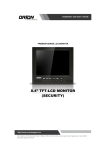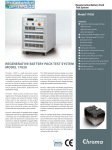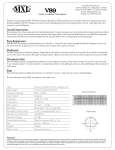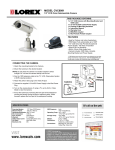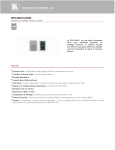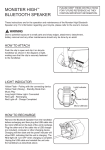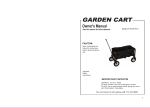Download Sun Bicycles Tug- A
Transcript
Sun Bicycles Tug- A-Bug User’s Manual Please read and understand the information in this manual before installing and using your new Sun Bicycles Tug-A-Bug trailer. Compatibility: This trailer is designed, and should only be attached to adult bicycles with a 26", 27" or 700C rear wheel. It connects to the seat post which must be 25.4mm, 27.2mm, or 28.6mm in diameter. The bottom of the hitch once attached must be at least 25 inches from the ground. The towing bicycle must have a cromoly seat post. Steel or Alloy may bend or break. 3) Install the seat post back into the bicycle and clamp securely. There must be a minimum of 3" of seat post inside the frame. Tighten the bolts on the hitch to remove play while at the same time allowing the hitch to swing from left to right. 4) Re-attach the trailer to the hitch with the quick release binder bolt. Use the original supplied binder bolt. Do not substitute the supplied binder bolt with any other type of binder. Make sure to re install the safety pin. This will insure the quick release binder bolt’s nut does not come loose. Weight Limits: The trailer can carry 1 rider with the maximum weight of 85lbs. The front rider must be at least 150lbs to maintain proper control of both the bicycle and the trailer when in motion. The Sun Bicycles Tug-A-Bug is not a baby seat. It is for use with children that are already able to ride a bicycle without training wheels. Proper Operation: This trailer is designed for paved roads. Use on rough roads could cause loss of control. Do not exceed 12mph. Riding faster than 12mph could cause loss of control and possible injury or death to either rider. This trailer is not designed for and should not be used at night. Plastic washers. Pictured top is the hitch assembly disassembled. Below left is the seatpost with part of the hitch assembly attached. Pictured right is the nut and bolt of the quick release opposite the lever. PIN MUST BE FULLY ENGAGED. Do not overtighten bolts Installation To install the hitch to the towing bicycle: 1) Remove the hitch from the trailer by removing the quick release binder. Be careful not to lose the plastic washers. 2) Remove the seat post from the towing bicycle and confirm it is made of cromoly, not steel or alloy and then determine the diameter. Slide the proper sized plastic shim on the seat post and install the hitch over the shim, on the seatpost. The protruding ridge on the shim (flange) should be at the base of the hitch. This will keep the plastic shim from rising up out of the hitch during operation and protect your frame from damage. The plastic ridge must rest against the top of your bicycles seat post clamp to insure the hitch will not lower itself during operation. IMPORTANT: DO NOT TIGHTEN COMPLETELY THE BOLTS SECURING THE HITCH ASSEMBLY TO THE SEAT POST. Tighten enough to eliminate play, however, the hitch assembly must swing freely from right to left. Shim flange under hitch assembly Shim flange between hitch assembly & seat colar Pin must be fully engaged, pressed through the QR hole. Left is the entire hitch assembly attached to the bicycle’s seat post. Do not overtighten bolts. Tighten enough to allow the hitch to swing. Quick Release Lever Operation CAUTION: Never fasten the Sun Bicycles Tug-a-Bug to the seat post by tightening the quick release lever as though it were a wing nut. Simply rotating the lever in a circular motion until tight will not fasten the hitch to the seat post. Detachment of the Tug-a-Bug as a result of improper quick release installation can result in serious bodily injury. NOTES If the quick release lever can be easily pushed to the CLOSED position, this means the clamping strength is insufficient. Return the quick release lever to the position perpendicular to the bicycle frame. And again turn the adjusting nut clockwise to increase the clamping strength. Push the quick release lever back to the CLOSED position. If the clamping strength is adjusted too strong and the quick release lever cannot be pushed to the CLOSED position, turn the adjusting nut in a counter-clockwise direction to reduce the clamping strength. When doing this, do not fully release the adjuster nut. Turn it 1/8 of a revolution, and then try to push the lever to CLOSED, to set the maximum clamping strength with which you can push the quick release lever to the CLOSED position. POSITIONING OF THE QUICK RELEASE LEVER For safety, the quick release lever should be pointing backwards, running along the trailer hitch arm when in the CLOSED position. Adjustment and pre ride check: Prior to each use, the following must checked to insure a safe ride. 1) Check that the hitch is in the lowest position on the seat post and the plastic shim is properly installed. 2) Check to insure the quick release hitch pin is properly installed and tight, and that the safety pin is installed. 3) Check that the trailers seat is tight and level. Adjust the saddle height so that the rider’s leg is slightly bent when the pedal is in the lowest position. 4) Check the trailers handlebar. Make sure it is tight and does not slip under pressure. Adjust the position so the rider can rest their hands comfortably with a slight bend in their elbow while seated in an upright position. 5) Check the tire pressure, which should be 35-to40psi. Inspect all bolts, nuts, and the frame and hitch of your trailer for wear. If any wear exists contact your local Sun Bicycles Tug-A-Bug dealer for replacement parts and do not use your trailer until those parts have been replaced. Serious injury or death could occur to either rider in the event of a failure. Protective Apparel: closed open Pictured above left is the quick release lever in the closed position. Above right is the quick release in the open position. IMPORTANT: DO NOT TIGHTEN THE QUICK RELEASE LEVER AS THOUGH IT WERE A WING NUT. Tighten and then press the lever firmly into closed position. The rider of the bicycle and the rider of the trailer must always wear a helmet. Unlike operating a bicycle without a trailer, there is more chance for a loss of control leading to an accident. It is recommended that elbow and knee pads also be worn for protection.




